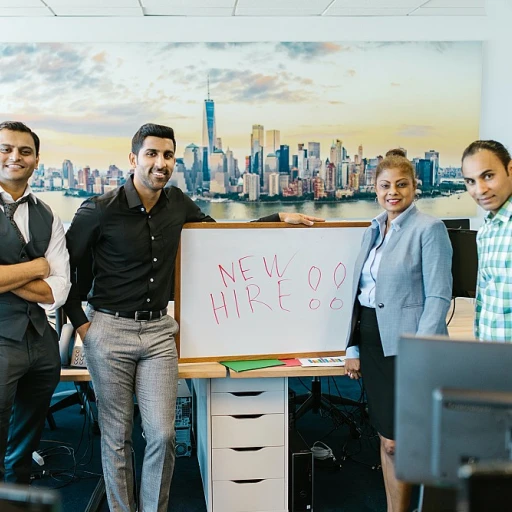Understanding the Role of Teambuilding in Employee Engagement
The Importance of Team Dynamics in Employee Engagement
Understanding how team dynamics influence employee engagement is crucial to enhancing organizational performance. Effective team building plays a pivotal role in fortifying these dynamics, ensuring that team members collaborate efficiently, communicate openly, and enjoy their work environment.
Teambuilding activities are instrumental in fostering a sense of camaraderie and trust among team members. These activities range from simple icebreakers in small groups to more structured team building exercises designed for larger teams. By engaging in team building games, participants can develop their communication skills, improve teamwork, and break the ice in a fun setting, which is essential for creating a cohesive work environment.
Moreover, team building facilitates better problem-solving capabilities within teams. Through well-planned exercises, groups can enhance their collective problem-solving skills in a stress-free atmosphere. This not only boosts the team's confidence but also fosters a collaborative mindset, preparing them for future challenges at work.
The benefits of effective team building are extensive. They contribute to a positive company culture that values collaboration and inclusion. Teams that participate in building exercises regularly can experience improved trust and bonding, leading to increased engagement and productivity.
For organizations seeking to optimize their team dynamics and ultimately boost employee engagement, understanding the stages of group development from formation to peak performance is essential. For more insights, consider exploring our detailed guide on
navigating team development.
Identifying Key Elements of Successful Teambuilding Activities
Essential Components for Productive Team Building Sessions
Effective team building activities are instrumental in enhancing team dynamics and fostering employee engagement. To achieve the desired impact, several key elements must be considered when planning these activities.
Clear Objectives
- Define what you aim to accomplish through the team building exercise. Whether it is improving communication skills, enhancing problem-solving abilities, or promoting teamwork, clear objectives guide the design and execution of activities.
- Consider the needs of the group and adapt the activities accordingly to enhance relevance and effectiveness.
- Ensure alignment with the company culture to facilitate a cohesive experience for all participants.
Appropriate Group Size
- The size of the group plays a crucial role in the success of any activity. Smaller groups can foster more intimate interactions, whereas larger groups might require structured dynamics to ensure everyone participates.
- Select activities that accommodate your team size, balancing team bonding opportunities with the practicalities of large or small teams.
Inclusive and Engaging Activities
- The nature of the activity should be engaging for all team members, ensuring it includes an element of fun to break the ice and promote an open atmosphere.
- Diverse options ranging from problem-solving games to communication exercises should be considered to cater to varied interests and facilitate learning from multiple perspectives.
- Utilize innovative approaches such as virtual team building exercises in hybrid work setups where in-person interaction is limited.
Time Management
- Respect the time of your participants by outlining the duration of each activity. Short, well-planned sessions (often lasting no more than 30 minutes) can be particularly effective.
- Avoid lengthy activities that may lead to disengagement; instead, focus on concise, impactful exercises.
Measurable Outcomes
- Set measurable outcomes to determine the success of the session. These outcomes should align with the original objectives and be assessable post-activity to evaluate improvements in teamwork and communication skills.
- Feedback from participants can also offer valuable insights, guiding future team building initiatives.
For further insights into the significance of these activities, explore the phases of team development and their implications
here.
Overcoming Common Challenges in Teambuilding
Addressing Obstacles in Building Activities
Teambuilding activities are instrumental in enhancing team dynamics, yet they often encounter several challenges that may hinder their success. By understanding and addressing these obstacles, organizations can create a more effective and engaging experience for all participants.
1. Diverse Group Sizes
One challenge in designing teambuilding activities is accommodating teams of various sizes. Whether coordinating a small group or a larger team, ensuring that everyone is actively involved is essential. Customizing activities like team bonding exercises or problem-solving games to fit the group size can help maintain engagement. Using subgrouping strategies where team members break into smaller units can also be a practical approach.
2. Time Constraints
Time is a critical factor that can limit the effectiveness of team activities. With packed work schedules, finding time for teambuilding can be challenging. Organizations should schedule activities during work hours and limit them to manageable durations, such as 30 to 60 minutes, to encourage participation. Activities that are both brief and impactful, such as icebreaker games or quick team-building exercises, maximize the return on time invested.
3. Participant Engagement
Engagement levels can vary among team members, as some may view these activities as forced or superficial. To overcome this, consider incorporating fun, innovative games that align with participants' interests. Those activities fostering teamwork and communication skills are particularly effective. Encourage input from the team on what types of activities would be enjoyable and beneficial, increasing the likelihood of active participation.
4. Virtual Teams
In the age of remote work, virtual team dynamics present unique challenges. Virtual team-building activities must be thoughtfully designed to break the ice and foster connection among remote team members. Leveraging digital platforms to facilitate interactive games and exercises can aid in overcoming virtual barriers.
To enhance company culture through teambuilding, organizations must recognize and navigate these common challenges effectively. In doing so, they ensure that activities meet the diverse needs of their team and contribute meaningfully to employee engagement. Explore crafting an
effective needs assessment to better identify and address these challenges, ensuring a healthy and collaborative work environment for all.
Innovative Teambuilding Ideas for Modern Workplaces
Exploring Contemporary Approaches for Fostering Team Spirit
Teambuilding activities have evolved to accommodate the dynamic nature of modern workplaces. Encouraging team spirit has shifted from traditional methods to innovative strategies that cater to diverse workforce needs. These activities are not just about having fun, but they effectively strengthen interpersonal relationships and improve overall work efficiency.
Start by assessing the team’s needs before implementing an activity. This involves understanding the group size, member skills, and company culture. Once these aspects are clear, tailor activities that address specific challenges such as communication skills or problem-solving abilities.
For smaller teams, quick yet impactful building exercises can be integrated into regular schedules. For example, exercises like "Two Truths and a Lie" can serve as icebreakers in virtual team meetings, fostering a sense of connection even from a distance. This activity requires each team member to share two truths and one lie about themselves, and the rest of the team has to guess the lie. It's a simple, quick game that enhances both teamwork and camaraderie.
In larger teams, activities involving collaboration on a creative project or a shared goal can be more appropriate. Consider organizing a team bonding event that involves a community service project. Not only does this engage team members in a meaningful task, but it also aligns with positively impacting society, adding value beyond the workplace.
Virtual team building is another domain ripe with innovative ideas. Virtual escape rooms and online trivia games can provide fun, engaging opportunities for team bonding without geographical constraints. Ensure these activities include all participants to maintain inclusivity.
Remember that timing is crucial. Short exercises that can be completed in a few minutes are often the best fit for a busy workday, while more extensive activities can be scheduled during offsite gatherings or retreats for maximum impact.
The key to a successful teambuilding activity is its alignment with both team goals and individual interests. By thoughtfully integrating these contemporary approaches, teams not only enhance their dynamics but also evolve to meet the challenges of the modern workplace with resilience and creativity.
Measuring the Impact of Teambuilding on Employee Engagement
Evaluating Participation and Engagement Levels
Understanding how effectively teambuilding activities engage team members is crucial for any company that invests in team building. An essential component of measuring success involves evaluating how actively participants involve themselves in activities, exercises, and games. In short, assessing participant engagement can offer insight into the activities that are most effective at building communication skills and fostering teamwork.
Feedback and Surveys
Obtaining feedback directly from team members through surveys or open discussions provides a straightforward evaluation method. These tools enable team members to express their thoughts on what they found effective, fun, or insightful. Additionally, feedback assists in tailoring future activities to better accommodate varying group sizes and preferences, ensuring all activities remain engaging and inclusive.
Observing Group Dynamics
Another way to measure the impact of teambuilding is by observing group dynamics during and after the activities. Are group interactions facilitated more smoothly? Has the problem-solving process become more efficient? By watching these dynamics, you can gain insights into how team building has impacted communication and collaboration within the team.
Tracking Team Performance Improvements
Analyzing performance data before and after implementing teambuilding exercises can also help determine their effectiveness. A noticeable improvement in work outcomes or team efficiency suggests that the building activities have successfully enhanced teamwork. Evaluating specific metrics like project completion times or the quality of work produced post-activity can highlight improvements in teamwork and bonding among team members.
Long-term Impact Evaluation
Beyond immediate improvements, assessing the long-term effects of teambuilding activities can reveal their true benefit. Sustained improvements in company culture or consistent high levels of team bonding suggest that past efforts are yielding results. Highlighting these lasting benefits strengthens the justification for continual investment in teambuilding activities.
Incorporating these evaluation methods ensures that the time and resources dedicated to teambuilding yield tangible and meaningful improvements within the workplace. Regularly measuring the impact of these activities also ensures they remain effective and valuable for all participants involved.
The Future of Teambuilding in a Hybrid Work Environment
Adapting Teambuilding for a Changing Work Landscape
In today's evolving work environment, the integration of hybrid and remote work models has introduced new dynamics to team building activities. Organizations are increasingly recognizing the need to adapt traditional practices to ensure all team members, regardless of location, feel engaged and connected.
The shift towards hybrid work requires innovative approaches that incorporate both in-person and virtual team building exercises. These activities can include a mix of virtual games and in-person events, allowing employees from different geographical locations to participate together. It's essential to focus on inclusivity when planning these activities, ensuring that team members from various time zones or with different group size preferences can engage meaningfully.
Another critical aspect is the technology used in facilitating virtual team building activities. Reliable communication platforms and collaboration tools must be prioritized to foster effective teamwork. Group exercises such as online problem solving and virtual break ice sessions can help maintain a cohesive company culture across distances.
Moreover, with the growing emphasis on agility in the workplace, it's important to create flexible team building games that can be adjusted based on team size and participation. Small groups may benefit from intimate team bonding exercises, while larger groups could engage in broader team building games that emphasize communication skills and teamwork.
As we look toward the future, incorporating elements of fun and engagement into both virtual and physical settings will be crucial. Creativity will remain paramount, driving the development of activities that are not only enjoyable but also beneficial in strengthening the team dynamic. Employers who embrace this new landscape and remain responsive to the evolving needs of their teams will see the greatest impact on employee engagement and overall productivity.












